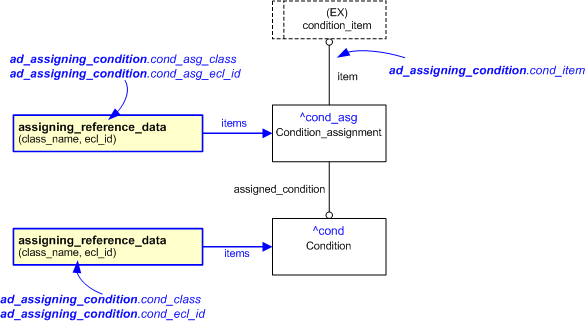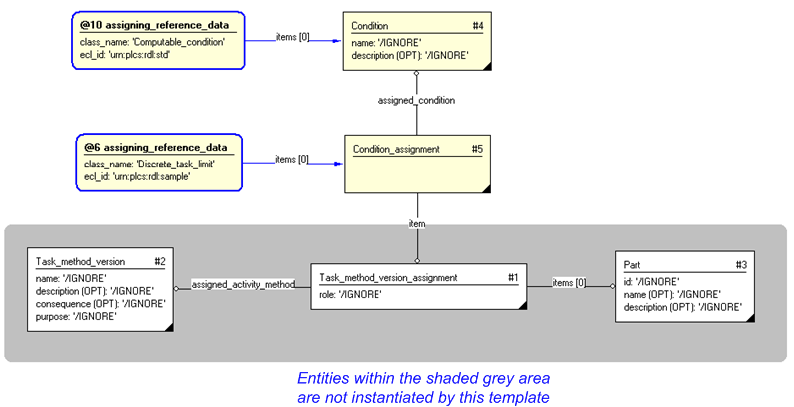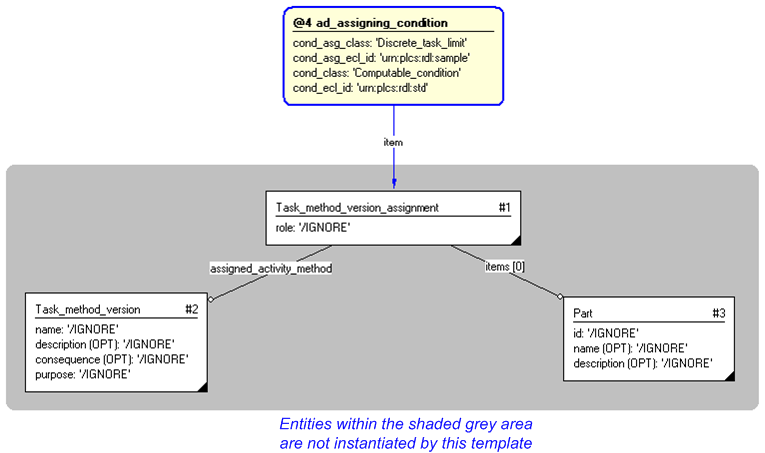Template:— ad_assigning_condition (ad_asg_cond)
Context:— Aerospace_and_Defense |
Date: 2011/04/20 12:51:56
Revision: 1.2
|
This section specifies the template ad_assigning_condition.
NOTE
The template has been defined in the context of
Aerospace_and_Defense.
Refer to the business context for details of related templates.
NOTE
An explanation of a template and the associated instantiation path is
provided in the
Template overview
section.
This template describes how to represent and assign a condition.
The EXPRESS-G diagram in
Figure
1
shows the templates and EXPRESS entities that are required
to represent the template
"ad_assigning_condition".
The text highlighted in blue shows the template parameters.
Figure 1 — An EXPRESS-G representation of the Information model for ad_assigning_condition
The graphic for the template to be used in other EXPRESS-G diagrams
is shown in Figure
2
below.
Figure 2 — The graphical representation of the ad_assigning_condition template
The following input parameters are defined for this template:
The item to which the condition is assigned
The following classes and their sub-classes can be used:
The following classes and their sub-classes can be used:
The following reference parameters are defined for this template:
Allow the
Condition
entity instantiated in this path to be referenced when this template is used.
Note: The
Condition
entity can be referenced in a template path by:
%^target = $ad_assigning_condition.cond%
where
target
is the parameter to which the
Condition
is bound.
Allow the
Condition_assignment
entity instantiated in this path to be referenced when this template is used.
%^target = $ad_assigning_condition.cond_asg%
The instantiation path shown below specifies the entities that are to be
instantiated by the template.
A description of templates and the syntax for the instantiation path is
provided in the
Templates Help/Information section.
The following entities are instantiated with attributes as specified:
The instance diagram in Figure
3
shows an example of the EXPRESS entities and templates that are instantiated by the template:
/ad_assigning_condition(cond_item='#1', cond_asg_class='Discrete_task_limit', cond_asg_ecl_id='urn:plcs:rdl:sample', cond_class='Computable_condition', cond_class_ecl_id='urn:plcs:rdl:std')/
(an illustration of the consolidated ad_assigning_condition template is shown in
Figure
4 below.)
Figure 3 — Entities instantiated by ad_assigning_condition template
The instance model in STEP ASCII exchange file format (ISO 10303 Part
21 syntax) is:
#1 = TASK_METHOD_VERSION_ASSIGNMENT(#2,(#3),'/IGNORE');
#2 = TASK_METHOD_VERSION('/IGNORE','/IGNORE','/IGNORE','/IGNORE',$,$);
#3 = PART('/IGNORE','/IGNORE','/IGNORE');
#4 = CONDITION('/IGNORE','/IGNORE');
#5 = CONDITION_ASSIGNMENT(#4,#1);
#7 = CLASSIFICATION_ASSIGNMENT(#8,(#5),'/IGNORE');
#8 = EXTERNAL_CLASS('/NULL','Discrete_task_limit','/IGNORE',#9);
#9 = EXTERNAL_CLASS_LIBRARY('urn:plcs:rdl:sample','/IGNORE');
#11 = CLASSIFICATION_ASSIGNMENT(#12,(#4),'/IGNORE');
#12 = EXTERNAL_CLASS('/NULL','Computable_condition','/IGNORE',#13);
#13 = EXTERNAL_CLASS_LIBRARY('urn:plcs:rdl:std','/IGNORE');
The instance diagram in
Figure
4
shows the graphic symbol for the template that is to be
used in other instance diagrams. The example template is:
/ad_assigning_condition(cond_item='#1', cond_asg_class='Discrete_task_limit', cond_asg_ecl_id='urn:plcs:rdl:sample', cond_class='Computable_condition', cond_class_ecl_id='urn:plcs:rdl:std')/
Figure 4 — Instantiation of ad_assigning_condition template
Characterizations
No common characterizations of the template
ad_assigning_condition
have been identified. However, the ISO 10303-239 EXPRESS model
may enable other assignments to the entities instantiated by the template.




